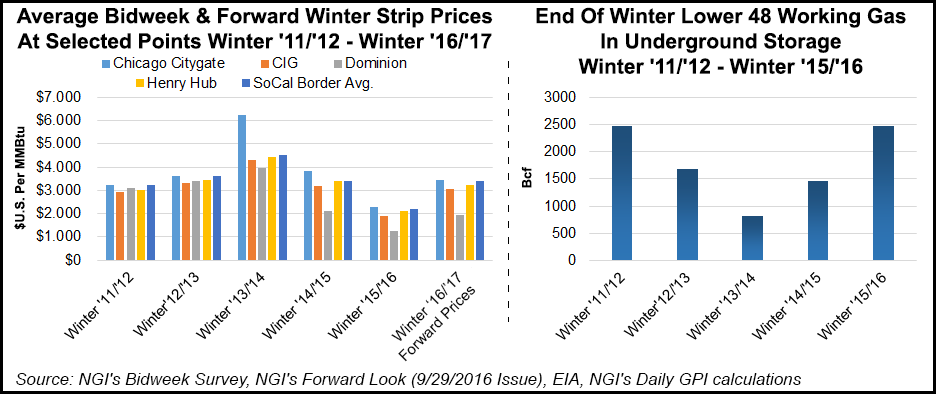NGI The Weekly Gas Market Report | Markets | NGI All News Access
Winter 2016-2017 May Be Long One For U.S. Northern Tier, Forecaster Says
The upcoming winter could be an extended one from the northern Plains to the natural gas-hungry population centers of the eastern United States, with cold and snowy conditions stretching into the spring, while the southern half of the nation is expected to be relatively mild and dry, according to a long-term forecast issued Wednesday by AccuWeather.

Temperatures in the Northeast are forecast to average 3-5 degrees F lower than last winter, but the region will have fewer subzero days than in an average winter, AccuWeather said. Frequent storms may lead to an above-normal season for snowfall in the Northeast, they said.
“I think the Northeast is going to see more than just a few, maybe several, systems in the course of the season,” said AccuWeather Long-Range Forecaster Paul Pastelok.
The Southeast, on the other hand, may see an extended autumn, with “very mild air” dominating the region through December, but a sudden burst of cold air is expected to come with the New Year, AccuWeather said.
“I am afraid that we have a shot at seeing a damaging freeze in central Florida in mid- to late January,” Pastelok said. Cold air will once again retreat following January and the threat is predicted to shift to severe weather as far north as Roanoke, VA, he said.
The southern Plains and Gulf Coast are also expected see fall-like weather lingering into winter, but a turnaround could come in late December and January as chillier air masses work down from the north, Pastelok said.
AccuWeather expects warm and dry conditions to span much of the winter for central and Southern California and the Southwest.
“December is [looking] very warm [in the Southwest] and I think we could break some record high temperatures,” Pastelok said. The pattern could exacerbate ongoing drought conditions in Southern California. “We’re in a pattern that doesn’t really show a lot of rain coming toward Southern California, so I don’t expect too much relief.”
But Northern California and the Northwest are likely to see early winter rain and snow, with snow pack beginning to form in mountain areas beginning in December, he said.
The northern Plains are forecast to average 6-9 degrees lower than winter 2015-2016, and cold air is expected to remain entrenched across the Midwest after arriving in late November.
Last week, the Energy Information Administration said natural gas inventories had reached 3,551 Bcf, which was 140 Bcf greater than last year and 268 Bcf more than the five-year average (see Daily GPI, Sept. 22). The traditional storage injection season is rapidly drawing to a close, and indications are that it will be a stretch to reach last year’s record build of 3,954 Bcf.
© 2024 Natural Gas Intelligence. All rights reserved.
ISSN © 1532-1231 | ISSN © 2577-9877 | ISSN © 1532-1266 |
